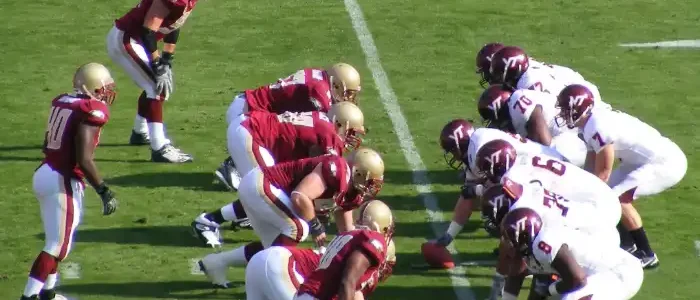
Football is a complicated sport with many positions, all of which have a distinct purpose. While quarterbacks and running backs are often the center of attention, linebackers are critical in determining how well a defense does. So what exactly is a linebacker, and why are they so important to any team’s success?

The Enforcers of the Defense: Understanding Linebackers
Linebackers can be described as middlemen between the front four and secondary players. They serve as the first-line defenders against running plays while also being able to drop into pass coverage during passing plays. On-field versatility and fast reflexes are their key attributes.
A solid core of linebackers can mean the difference between a dominant defense and a soft one. Linebackers have these responsibilities:
- Stopping The Run: As primary run stoppers, they plug offensive line creases and tackle ball carriers before they gain significant yardage.
- Pass Coverage: These positional players can fall back into coverage on specific receivers or zones depending on play calling. Their agility helps them cover tight ends or halfbacks coming out of the backfield.
- Pressuring The Quarterback: In some blitz packages, linebackers rush towards the passer to disrupt his rhythm and potentially cause turnovers.
- Defensive Leadership: Middle linebackers are often considered field generals by taking charge on the defensive side of the ball and making adjustments when needed, such as ensuring proper alignment with all other teammates.
Different Types Of Linebackers
All linebackers aren’t created equal. There are two main categories, each with its own unique skillset:
- Middle Linebacker (MLB): This is known as the Defense’s quarterback because he calls for plays at scrimmage lines along with seeing offensive formations; usually this player will have a bigger body frame than others who act defensively relating to controlling against runs or filling up holes at the center. These people often lead their team’s tackles, and they are usually the voice of defense.
- Outside Linebacker (OLB): Middle linebackers are generally slower but bigger than outside linebackers. The duties that an OLB performs may be different based on the defensive scheme:
- Strong-Side Linebacker (SAM): Sometimes positioned next to the tight end’s side in a formation, the strong-side linebacker is responsible for containing runs and pass-rushing in blitzes. Generally, strong-side linebackers are larger and more physically powerful than their weak-side counterparts.
- Weak-Side Linebacker (WILL): Typically lining up across from the tight end, weakside linebackers tend to drop into coverage more frequently. They must have speed and agility to stay with running backs or slot receivers.
The Art Of The Blitz: Essential Linebacker Techniques
An outstanding linebacker has to be well-versed in many skills. Some critical techniques that distinguish good linebackers from great ones are as follows:
- Tackling Fundamentals: For any linebacker, proper tackling form is vital. To bring down a ball carrier securely, they must wrap him while driving through his legs. Different situations necessitate different types of tackles, such as open-field tackles, head-on tackles, and sideline tackles, which require specific techniques for a safe and effective takedown.
- Coverage Skills: Man coverage and zone coverage are among the things that linebackers should be good at. In zone coverage, they watch a specific area of the field, whereas in man coverage, they stick to a particular receiver. Efficient coverage requires a linebacker to read the pre-snap reads of the quarterback and react quickly as the play develops.
Linebacker Legends: The Enforcers Who Left Their Mark
The history of linebacking is filled with legendary names who sent shivers down their opponents’ spines. Here are some individuals who have redefined the position:
- Dick Butkus: Also known as “The Enforcer,” Butkus was a terror for anything moving on a football field between the sixties and seventies. His devastating tackles and unending pursuits made his name synonymous with nightmares for running backs during his time.
- Lawrence Taylor’s nickname, “LT,” represented dominance in this era that had its golden age in the eighties. He changed forever what it meant to be a linebacker by introducing speed, power, and devastating pass-rushing techniques.
- Ray Lewis: Lewis was an outstanding linebacker for the Baltimore Ravens from the late 1990s through the early 2000s, both on and off the field. His intensity, ability to tackle well, and ability to rally his teammates made him an exceptional defensive leader.
These famous players are just some examples, but there are many more great linebackers throughout history.
Building a Linebacker: The Road to Gridiron Glory
A successful linebacker needs a rigorous training program for both mental and physical development.
Physical Conditioning:
- Strength and Agility Training: To make tackles or shed blocks, developing lower body strength as well as strengthening your core is crucially important. Any linebacker workout routine includes powerlifting, plyometrics, and agility drills.
- Endurance and Speed Drills: To play through an entire game, linebackers need to have extraordinary stamina. Sprints, interval training, and position-specific drills help build the speed and endurance required for success on the field.
Mental Preparation:
- Studying the Opponent’s Tendencies: Linebackers need to watch films of their opponents. They should pick up running patterns and identify other teams’ tendencies as regards offensive strategies.
- Understanding Defensive Schemes and Adjustments: Linebackers must know their defense’s schemes completely to find out what might be causing a breakdown in their assignments. The offensive formation will determine how they can effectively communicate with teammates or change tactics accordingly.
Conclusion
Linebackers are simply indispensable in any solid defense. Their multi-tasking skills, coupled with their athleticism and football IQ, set them apart. These linebackers must contain the unstoppable running back or guard the wide receiver all over the field, thus making them the most feared football players who ever existed on earth’s surface.
So next time you are watching a football match, pay attention to linebackers: notice how they pursue relentlessly, make power tackles, and think strategically about defensive plans.

